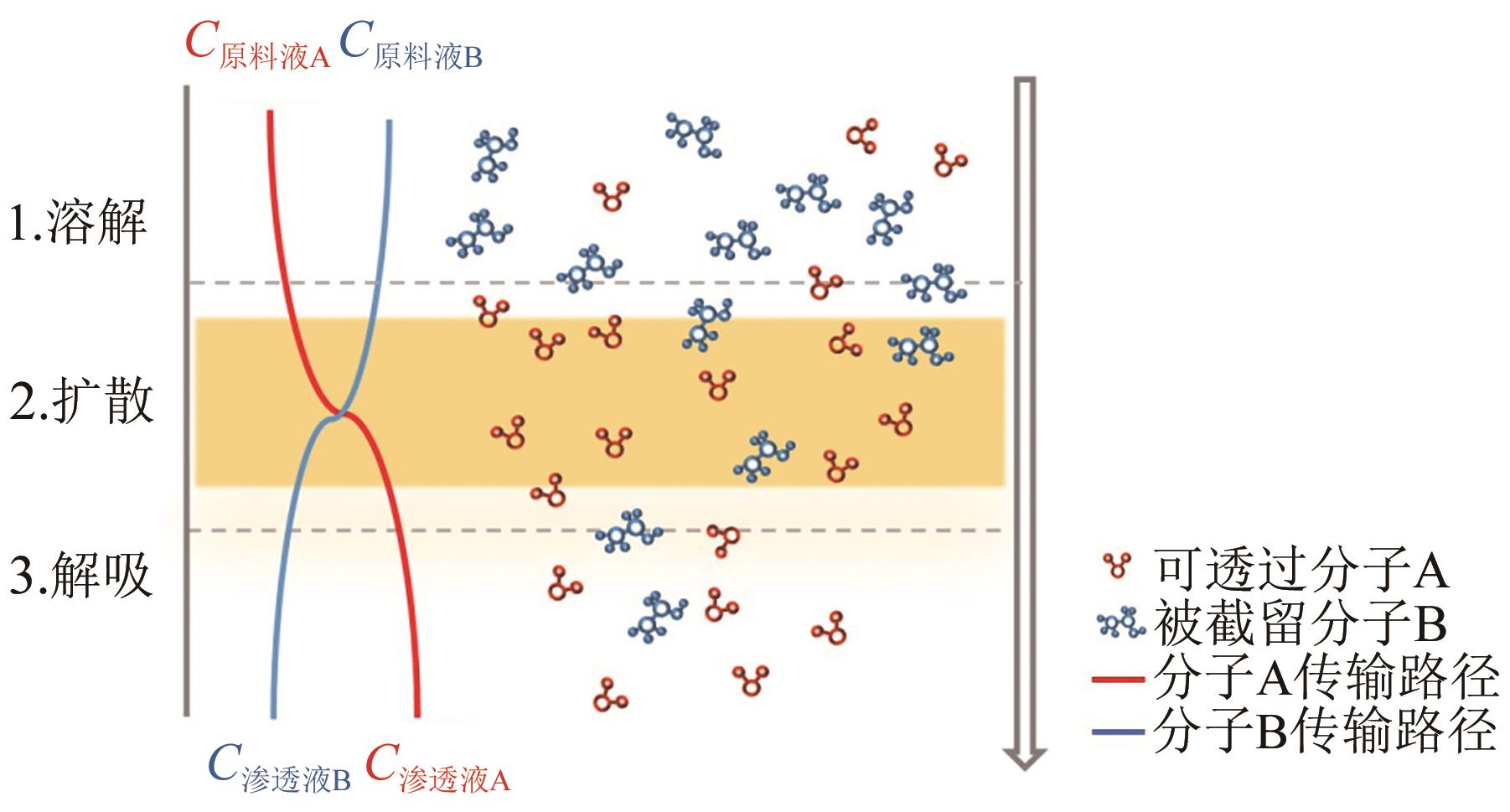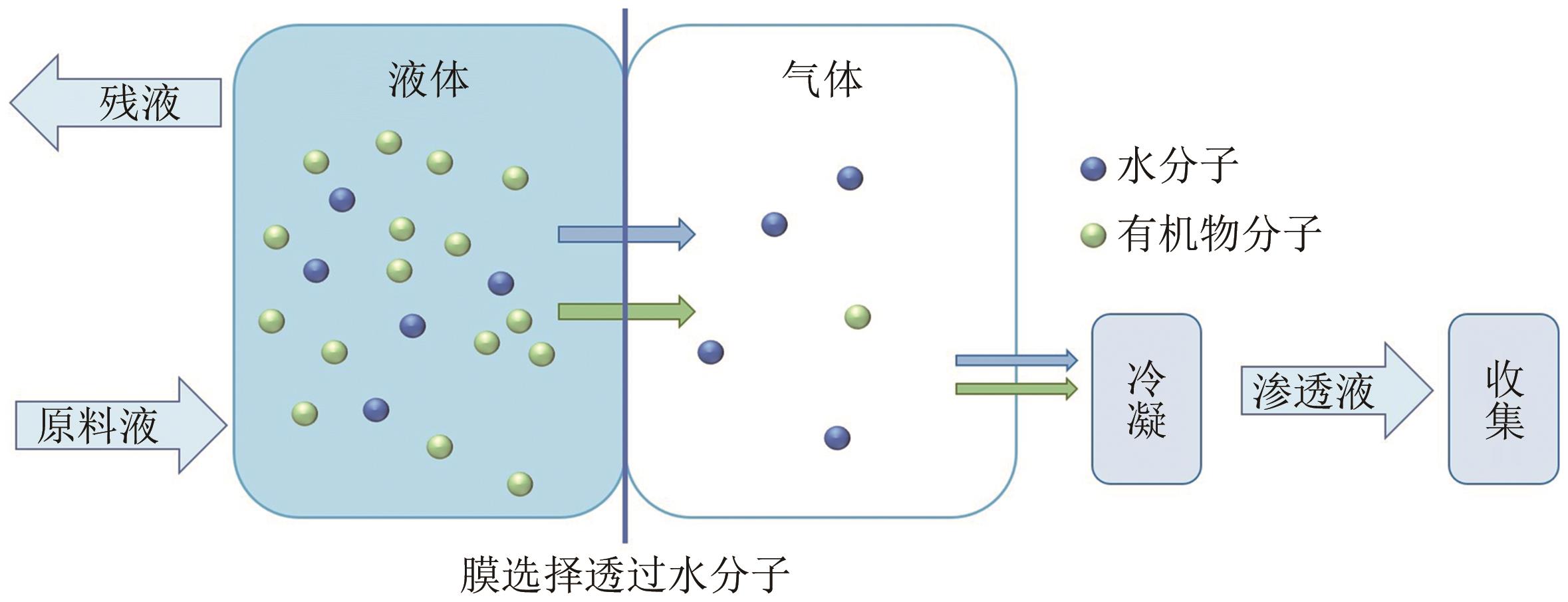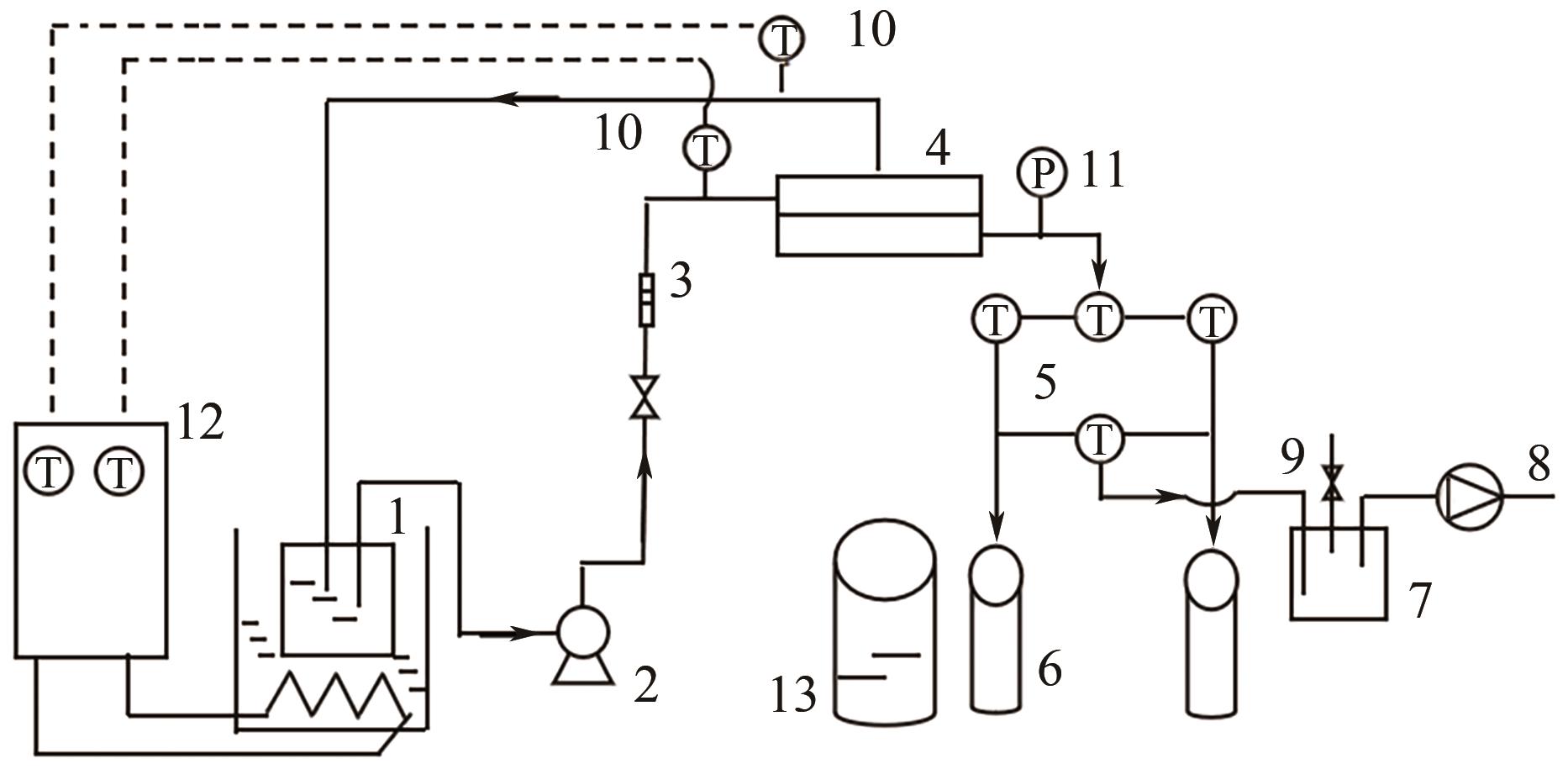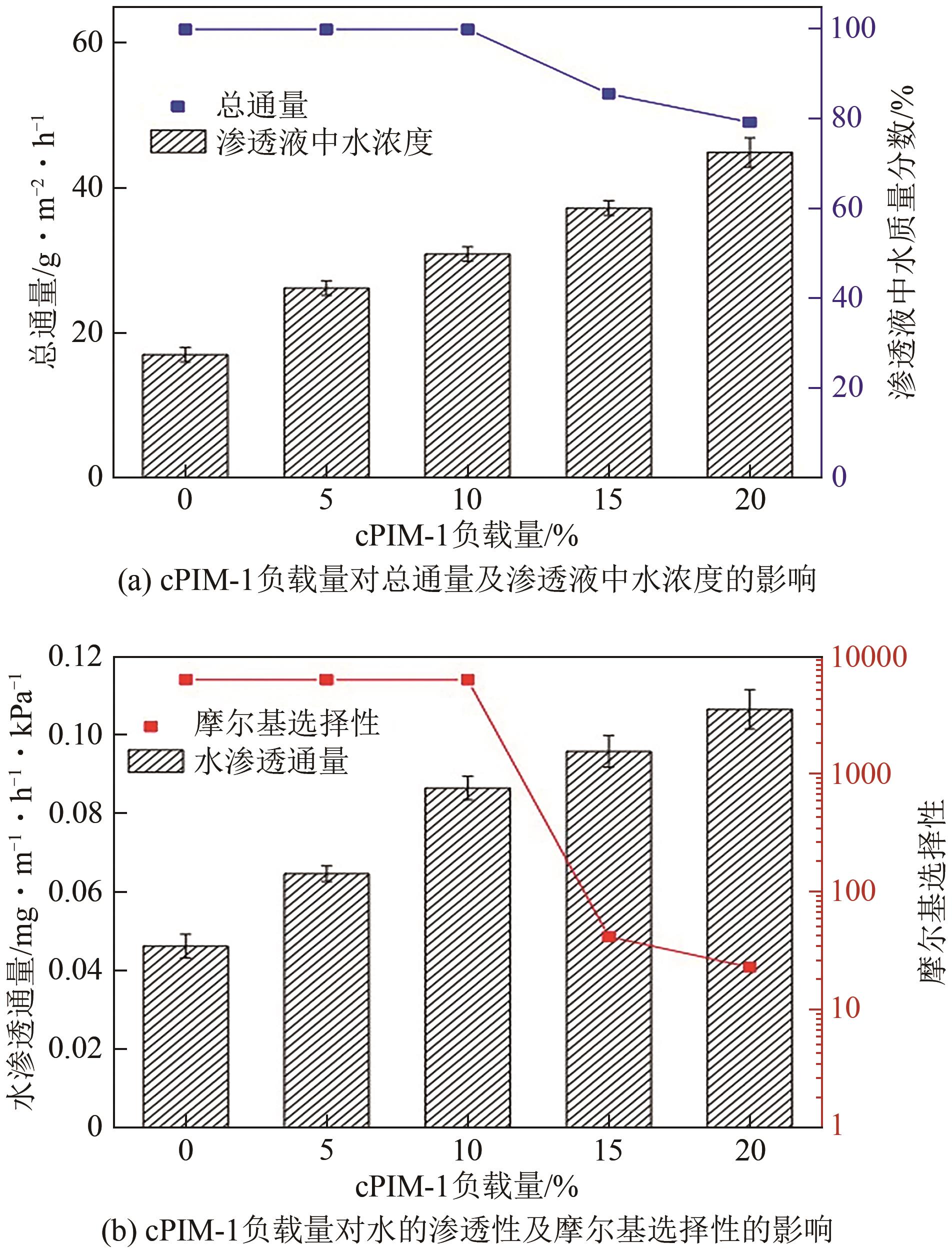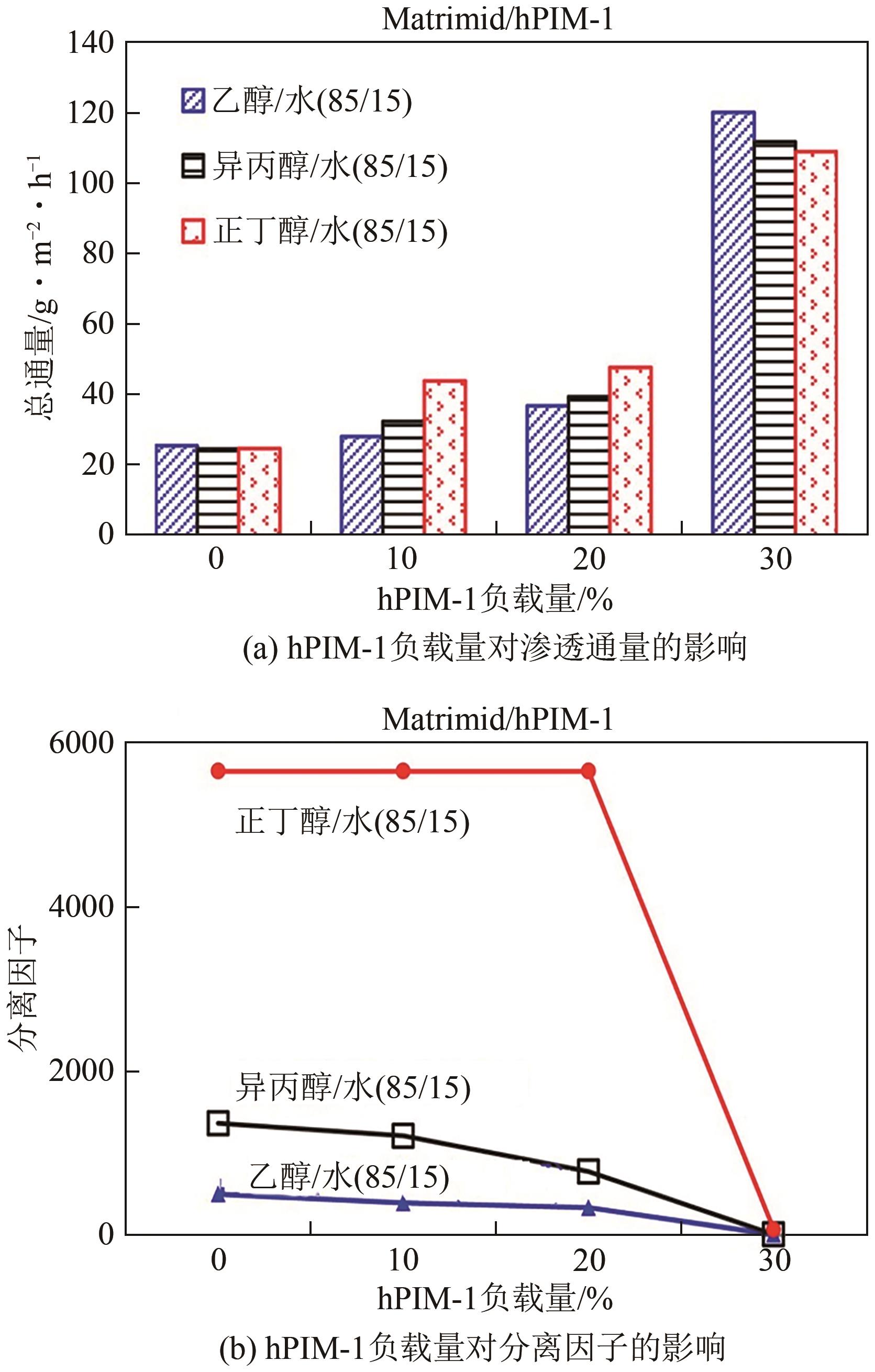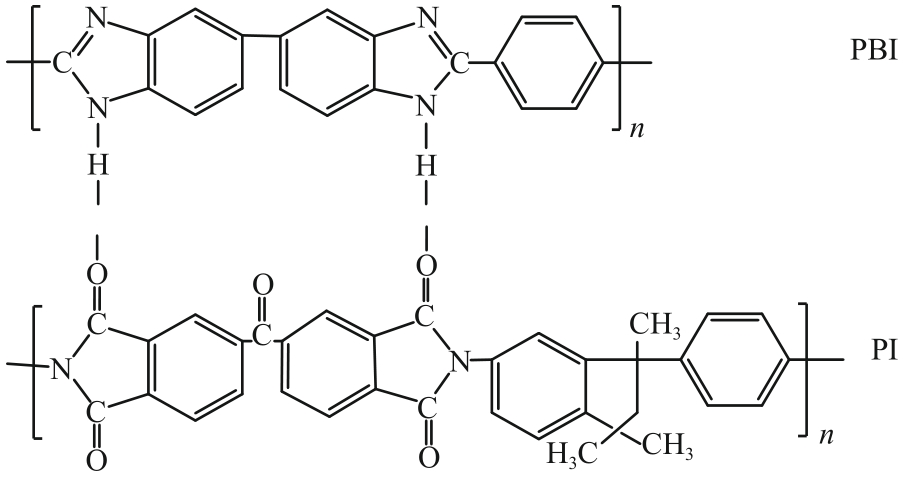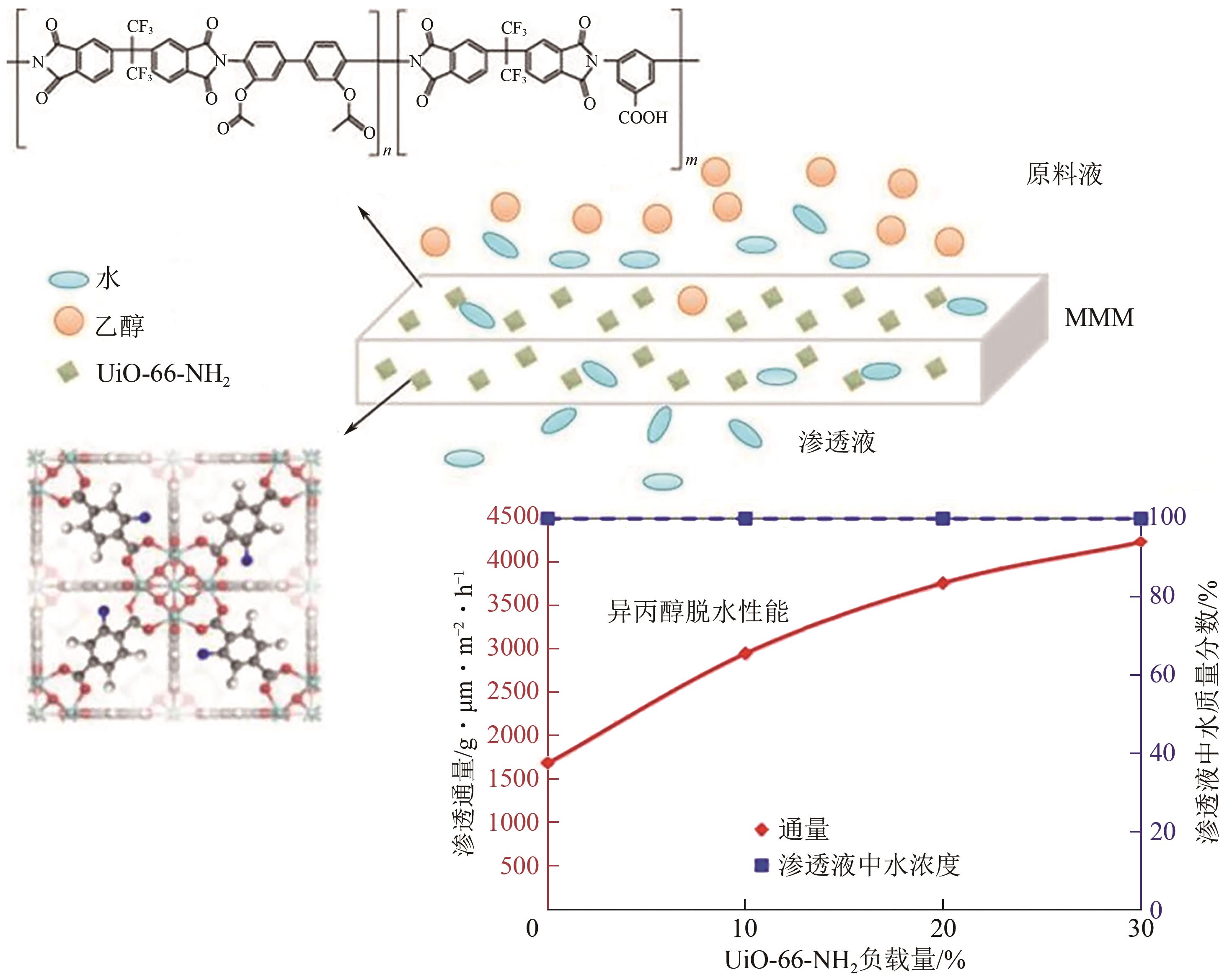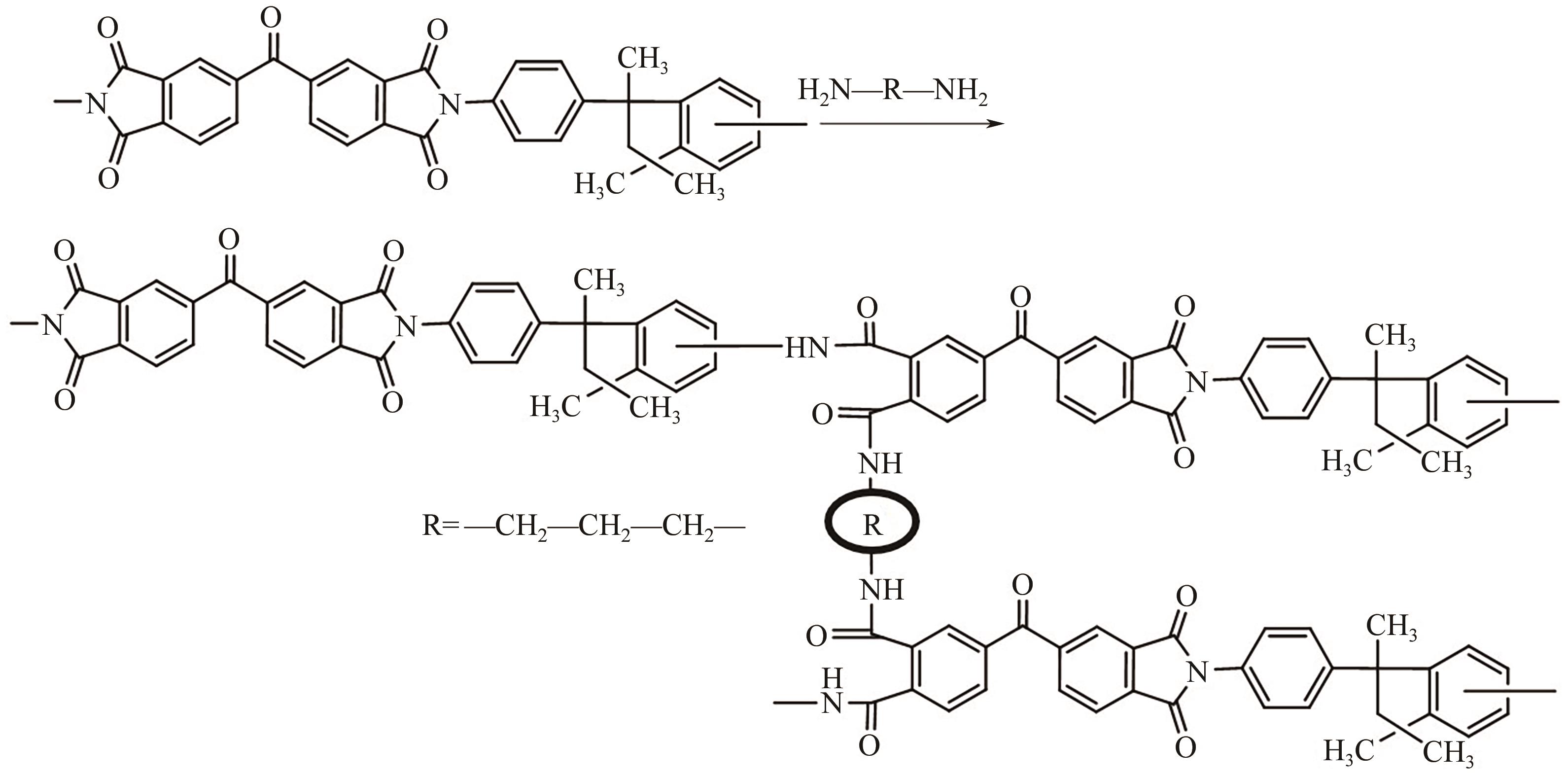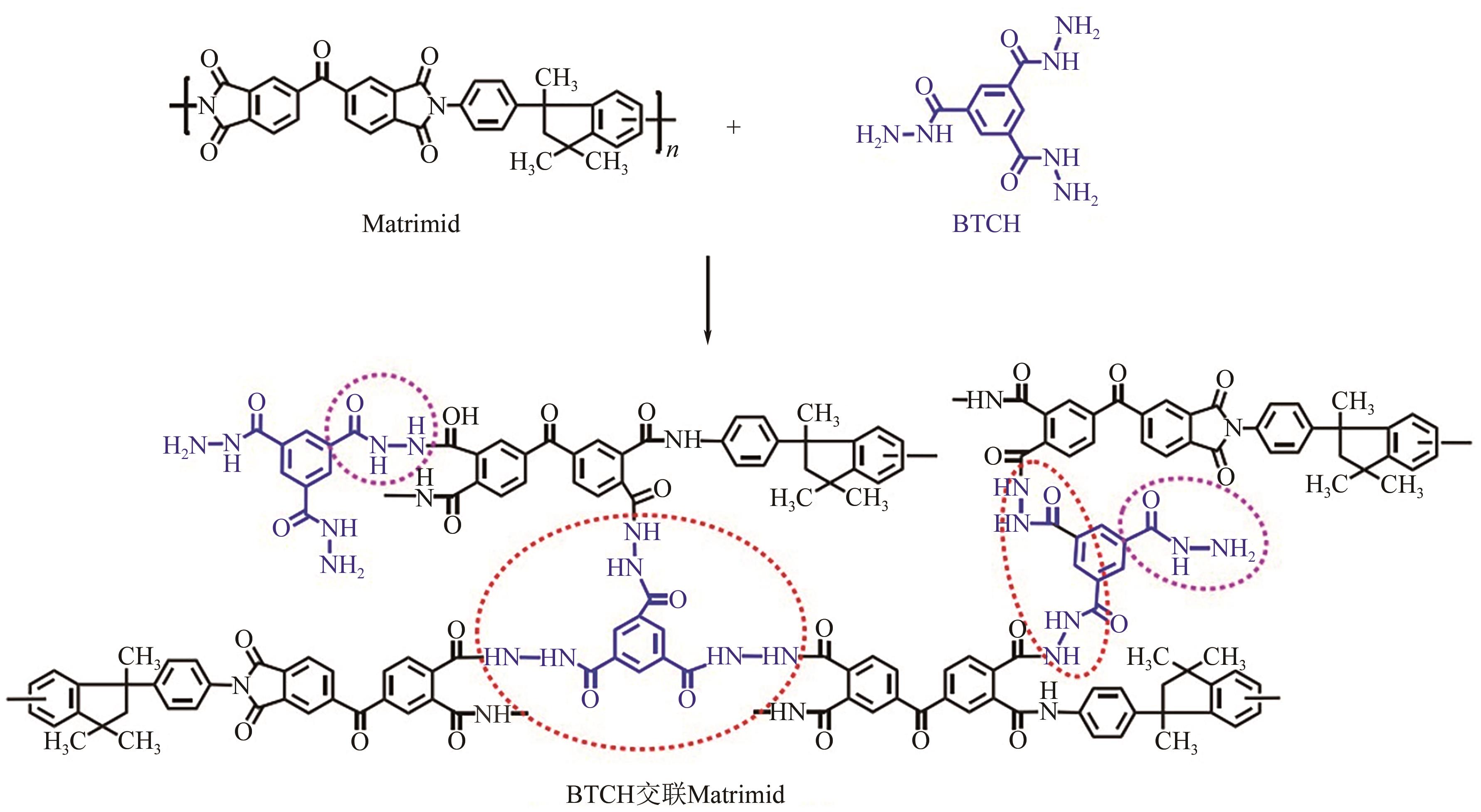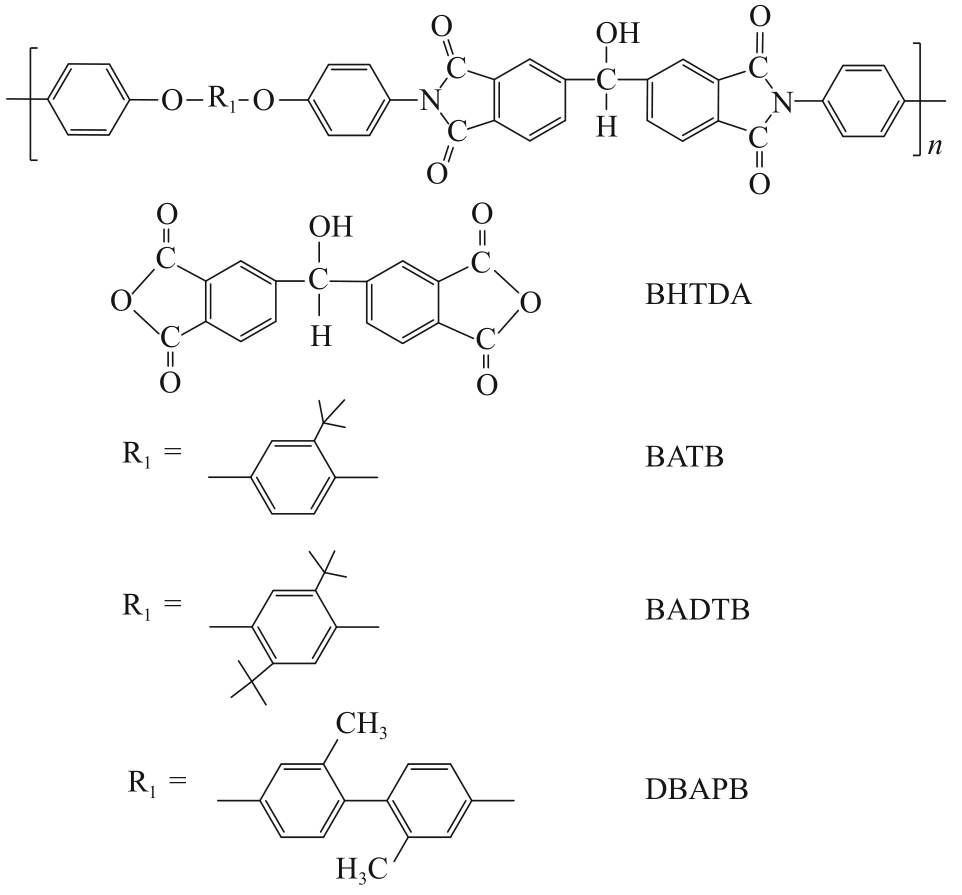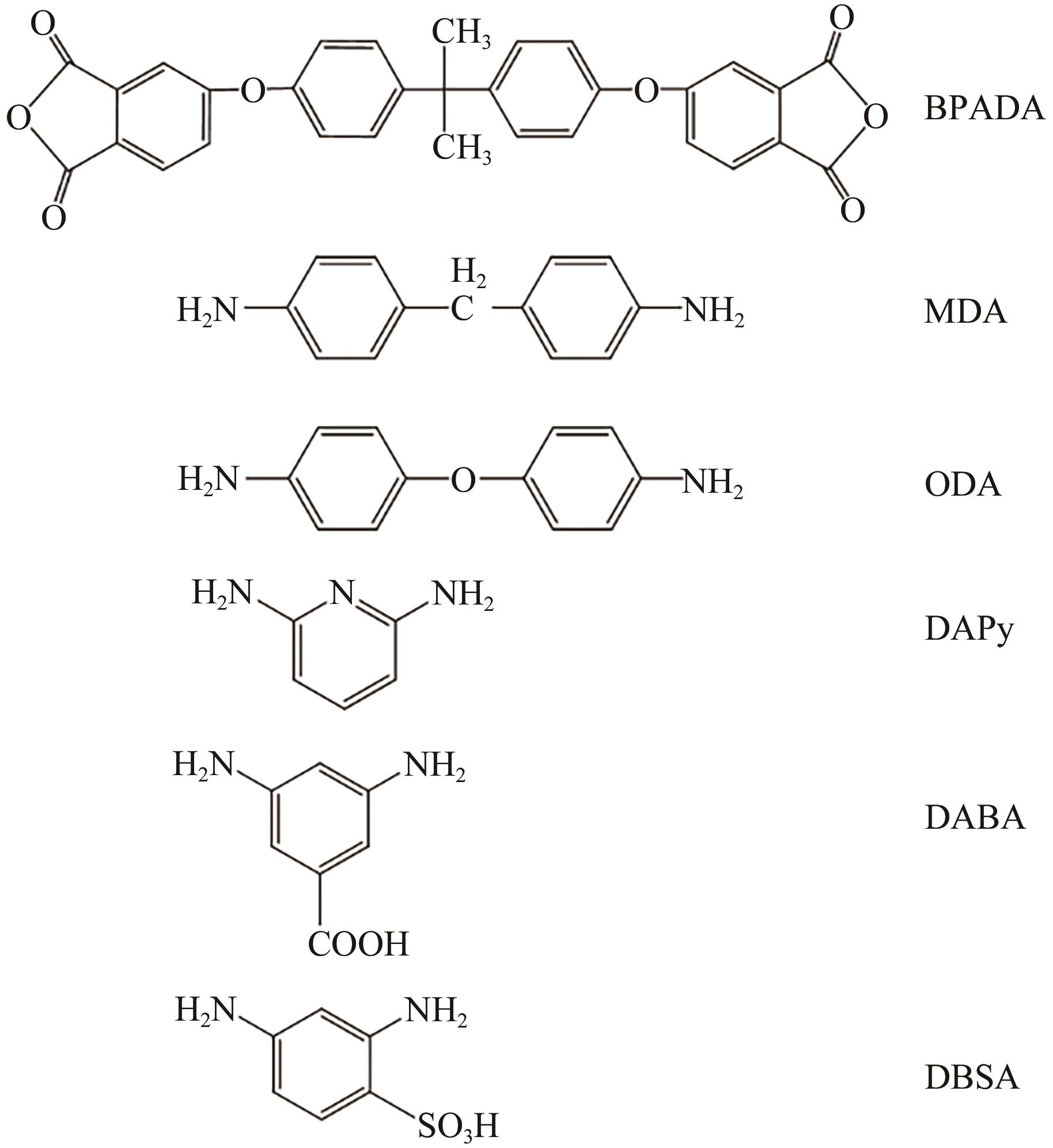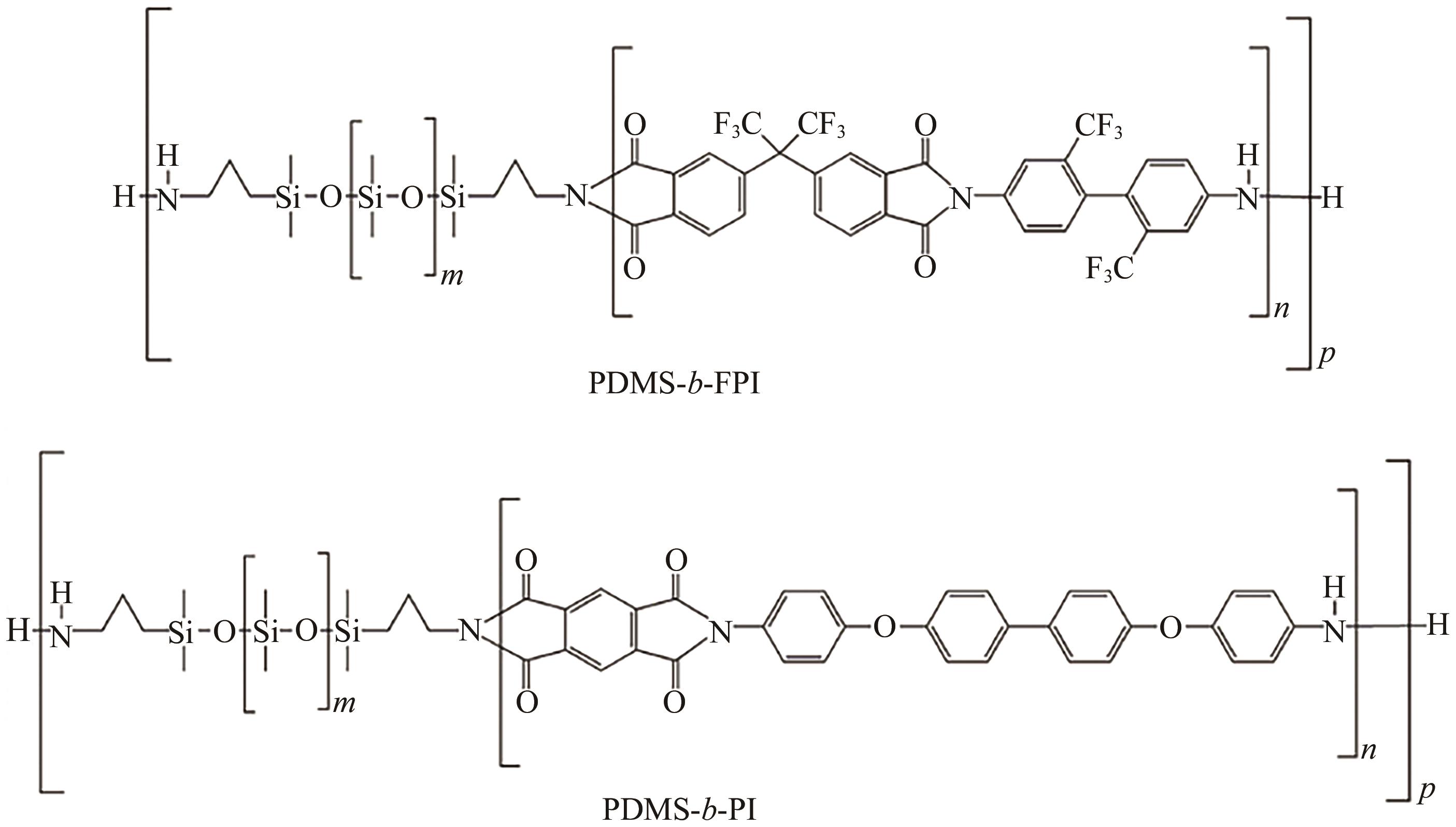Chemical Industry and Engineering Progress ›› 2024, Vol. 43 ›› Issue (6): 2915-2927.DOI: 10.16085/j.issn.1000-6613.2023-0846
• Chemical processes and equipment • Previous Articles
Modified polyimide pervaporation membranes for dehydration of organic solvent
LI Yan( ), WU Qin(
), WU Qin( ), CHEN Kangcheng(
), CHEN Kangcheng( ), ZHANG Yaoyuan, SHI Daxin, LI Hansheng
), ZHANG Yaoyuan, SHI Daxin, LI Hansheng
- School of Chemistry and Chemical Engineering, Beijing Institute of Technology, Beijing 100081, China
-
Received:2023-05-22Revised:2023-07-13Online:2024-07-02Published:2024-06-15 -
Contact:WU Qin, CHEN Kangcheng
聚酰亚胺渗透汽化膜用于有机溶剂脱水的改性研究进展
李妍( ), 吴芹(
), 吴芹( ), 陈康成(
), 陈康成( ), 张耀远, 史大昕, 黎汉生
), 张耀远, 史大昕, 黎汉生
- 北京理工大学化学与化工学院,北京 100081
-
通讯作者:吴芹,陈康成 -
作者简介:李妍(1999—),女,硕士研究生,研究方向为渗透汽化膜分离过程。E-mail:3220211419@bit.edu.cn。 -
基金资助:国家自然科学基金(21736001)
CLC Number:
Cite this article
LI Yan, WU Qin, CHEN Kangcheng, ZHANG Yaoyuan, SHI Daxin, LI Hansheng. Modified polyimide pervaporation membranes for dehydration of organic solvent[J]. Chemical Industry and Engineering Progress, 2024, 43(6): 2915-2927.
李妍, 吴芹, 陈康成, 张耀远, 史大昕, 黎汉生. 聚酰亚胺渗透汽化膜用于有机溶剂脱水的改性研究进展[J]. 化工进展, 2024, 43(6): 2915-2927.
share this article
Add to citation manager EndNote|Ris|BibTeX
URL: https://hgjz.cip.com.cn/EN/10.16085/j.issn.1000-6613.2023-0846
| 膜材料 | UiO-66-NH2负载量/% | 吸水率 /% | 甲醇 吸收率/% | 乙醇 吸收率/% | 异丙醇 吸收率/% |
|---|---|---|---|---|---|
| PI | 0 | 3.3±0.3 | 9.2±0.3 | 11.5±0.7 | 18.4±0.6 |
| MMM | 10 | 5.6±0.5 | 8.0±0.6 | 8.3±0.3 | 10.4±0.6 |
| MMM | 20 | 9.4±0.5 | 6.1±0.9 | 7.1±0.3 | 9.8±0.8 |
| MMM | 30 | 16.9±0.7 | 5.0±0.2 | 6.5±0.6 | 8.2±0.8 |
| 膜材料 | UiO-66-NH2负载量/% | 吸水率 /% | 甲醇 吸收率/% | 乙醇 吸收率/% | 异丙醇 吸收率/% |
|---|---|---|---|---|---|
| PI | 0 | 3.3±0.3 | 9.2±0.3 | 11.5±0.7 | 18.4±0.6 |
| MMM | 10 | 5.6±0.5 | 8.0±0.6 | 8.3±0.3 | 10.4±0.6 |
| MMM | 20 | 9.4±0.5 | 6.1±0.9 | 7.1±0.3 | 9.8±0.8 |
| MMM | 30 | 16.9±0.7 | 5.0±0.2 | 6.5±0.6 | 8.2±0.8 |
| 1 | WANG Xiaoyan, CONG Shenzhen, YAN Xueru, et al. Crosslinked benzimidazole-linked polymer membranes for dehydration of organics[J]. Separation and Purification Technology, 2023, 316: 123802. |
| 2 | FENG Xianshe, HUANG Robert Y M. Liquid separation by membrane pervaporation: A review[J]. Industrial & Engineering Chemistry Research, 1997, 36(4): 1048-1066. |
| 3 | SAPEGIN D A, GUBANOVA G N, KRUCHININA E V, et al. On the structure, morphology and transport through limitedly flexible chain sulfonated co-polyimide[J]. Polymer, 2021, 212: 123142. |
| 4 | MA Wenzhong, LI Taiyu, JIANG Chao, et al. Effect of chain structure on the solvent resistance in aprotic solvents and pervaporation performance of PMDA and BTDA based polyimide membranes[J]. Journal of Membrane Science, 2019, 584: 216-226. |
| 5 | ISMAIL A F, GOH P S, SANIP S M, et al. Transport and separation properties of carbon nanotube-mixed matrix membrane[J]. Separation and Purification Technology, 2009, 70(1): 12-26. |
| 6 | LI Yusi, THOMAS Elisabeth R, MOLINA Mariana Hernandez, et al. Desalination by membrane pervaporation: A review[J]. Desalination, 2023, 547: 116223. |
| 7 | 贾志谦. 膜科学与技术基础[M]. 北京: 化学工业出版社, 2012: 3. |
| JIA Zhiqian. Fundamentals of membrane science and technology[M]. Beijing: Chemical Industry Press, 2012: 3. | |
| 8 | XU Ligang, WANG Yali, LI Qunyan, et al. A methyl-modified silica layer supported on porous ceramic membranes for theenhanced separation of methyl tert-butyl ether from aqueous solution[J]. Membranes, 2022, 12(5): 452. |
| 9 | WANG Qing, LIANG Yu, HIROKI Nagasawa, et al. High-performance molecular-separation ceramic membranes derived from oxidative cross-linked polytitanocarbosilane[J]. Journal of the American Ceramic Society, 2020, 103(8): 4473-4488. |
| 10 | XIA Yinfeng, ZHANG Ming, TSANG Daniel C W, et al. Recent advances in control technologies for non-point source pollution with nitrogen and phosphorous from agricultural runoff: Current practices and future prospects[J]. Applied Biological Chemistry, 2020, 63(1): 1-13. |
| 11 | CHARIK Fatima Zohra, ACHIOU Brahim, BELGADA Abdessamad, et al. Optimal preparation of low-cost and high-permeation NaA zeolite membrane for effective ethanol dehydration[J]. Microporous and Mesoporous Materials, 2022, 344: 112229. |
| 12 | ZHOU Rongfei, HU Lili, ZHANG Youjun, et al. Synthesis of oriented zeolite T membranes from clear solutions and their pervaporation properties[J]. Microporous and Mesoporous Materials, 2013, 174: 81-89. |
| 13 | ZHU Haipeng, LI Renhao, LIU Guozhen, et al. Efficient separation of methanol/dimethyl carbonate mixtures by UiO-66 MOF incorporated chitosan mixed-matrix membrane[J]. Journal of Membrane Science, 2022, 652: 120473. |
| 14 | SORRIBAS Sara, KUDASHEVA Alina, ALMENDRO Eduardo, et al. Pervaporation and membrane reactor performance of polyimide based mixed matrix membranes containing MOF HKUST-1[J]. Chemical Engineering Science, 2015, 124: 37-44. |
| 15 | Sang Jun YEO, CHAUDHARI Shivshankar, KIM UiSeo, et al. Robust and water-selective natural-cellulose-nanofiber-reinforced polyvinyl alcohol composite membranes for pervaporation of isopropanol/water mixtures[J]. Chemical Engineering and Processing-Process Intensification, 2022, 179: 109046. |
| 16 | BURTS Katsiaryna, PLISKO Tatiana, DMITRENKO Mariia, et al. Novel thin film nanocomposite membranes based on chitosan succinate modified with Fe-BTC for enhanced pervaporation dehydration of isopropanol[J]. Membranes, 2022, 12(7): 653. |
| 17 | NAIK Manu L, SAJJAN Ashok M, YUNUS KHAN TM, et al. Fabrication and characterization of poly(vinyl alcohol)-chitosan-capped silver nanoparticle hybrid membranes for pervaporation dehydration of ethanol[J]. Gels, 2022, 8(7): 401. |
| 18 | Yee Kang ONG, SHI Guimin, LE Ngoc Lieu, et al. Recent membrane development for pervaporation processes[J]. Progress in Polymer Science, 2016, 57: 1-31. |
| 19 | 董玥, 董霄, 朱德兆, 等. 聚酰亚胺发展概况与应用展望[J]. 中国塑料, 2022, 36(9): 85-95. |
| DONG Yue, DONG Xiao, ZHU Dezhao, et al. Development and application prospect of polyimide[J]. China Plastics, 2022, 36(9): 85-95. | |
| 20 | STRATHMANN H. Asymmetric polyimide membranes for filtration of non-aqueous solutions[J]. Desalination, 1978, 26(1): 85-92. |
| 21 | 尹大学, 李彦锋, 张树江, 等. 聚酰亚胺材料溶解性能的研究进展[J]. 化学通报, 2005, 68(8): 576-584. |
| YIN Daxue, LI Yanfeng, ZHANG Shujiang, et al. Research progress of influence of monomer structures on polyimide solubility[J]. Chemistry, 2005, 68(8): 576-584. | |
| 22 | WEI Yayu, YANG Zhe, WANG Ling, et al. Facile ZIF-8 nanocrystals interlayered solvent-resistant thin-film nanocomposite membranes for enhanced solvent permeance and rejection[J]. Journal of Membrane Science, 2021, 636: 119586. |
| 23 | YONG Wai fen, SALEHIAN Peymen, ZHANG Liling, et al. Effects of hydrolyzed PIM-1 in polyimide-based membranes on C2—C4 alcohols dehydration via pervaporation[J]. Journal of Membrane Science, 2017, 523: 430-438. |
| 24 | CHUNG Tai-Shung, GUO Weifen, LIU Ye. Enhanced matrimid membranes for pervaporation by homogenous blends with polybenzimidazole (PBI)[J]. Journal of Membrane Science, 2006, 271(1/2): 221-231. |
| 25 | XU Yiming, CHUNG Tai-Shung. High-performance UiO-66/polyimide mixed matrix membranes for ethanol, isopropanol and n-butanol dehydration via pervaporation[J]. Journal of Membrane Science, 2017, 531: 16-26. |
| 26 | WANG Yan. Pervaporation dehydration of ethyl acetate via PBI/PEI hollow fiber membranes[J]. Industrial & Engineering Chemistry Research, 2015, 54(11): 3082-3089. |
| 27 | SALEHIAN Peyman, YONG Wai fen, CHUNG Tai-Shung. Development of high performance carboxylated PIM-1/P84 blend membranes for pervaporation dehydration of isopropanol and CO2/CH4 separation[J]. Journal of Membrane Science, 2016, 518: 110-119. |
| 28 | 钱军民, 李旭样. 聚酰亚胺改性和应用研究进展[J]. 绝缘材料, 2001, 34(6): 12-17. |
| QIAN Junmin, LI Xuyang. Advances in modification and application of polyimide[J]. Insulating Materials, 2001, 34(6): 12-17. | |
| 29 | XU Yiming, JAPIP Susilo, CHUNG Tai-Shung. Mixed matrix membranes with nano-sized functional UiO-66-type MOFs embedded in 6FDA-HAB/DABA polyimide for dehydration of C1—C3 alcohols via pervaporation[J]. Journal of Membrane Science, 2018, 549: 217-226. |
| 30 | LI Qianqian, LIU Quan, ZHAO Jing, et al.High efficient water/ethanol separation by a mixed matrix membrane incorporating MOF filler with high water adsorption capacity[J]. Journal of Membrane Science, 2017, 544: 68-78. |
| 31 | NGUYEN Tien Tran, JINSOO Kim, MOHD Roslee Othman. Microporous ZIF-8 membrane prepared from secondary growth for improved propylene permeance and selectivity[J]. Microporous and Mesoporous Materials, 2019, 285: 178-184. |
| 32 | ZHAN Zhiying, SHAO Jia, PENG Yong, et al. High performance zeolite NaA membranes synthesized on the inner surface of zeolite/PES-PI blend composite hollow fibers[J]. Journal of Membrane Science, 2014, 471: 299-307. |
| 33 | PETERSON Gregory W, MAHLE John J, DECOSTE Jared B, et al. Extraordinary NO2 removal by the metal-organic framework UiO-66-NH2 [J]. AngewandteChemie International Edition, 2016, 55(21): 6235-6238. |
| 34 | WANG Ting, SHEN Jiangnan, WU Liguang, et al. Improvement in the permeation performance of hybrid membranes by the incorporation of functional multi-walled carbon nanotubes[J]. Journal of Membrane Science, 2014, 466: 338-347. |
| 35 | CAO Keteng, JIANG Zhongyi, ZHAO Jing, et al. Enhanced water permeation through sodium alginate membranes by incorporating graphene oxides[J]. Journal of Membrane Science, 2014, 469: 272-283. |
| 36 | MA Wenzhong, LI Taiyu, ZHANG Qi. Preparation of hybrid membranes by incorporating hydrophilic UiO-66 nanoparticles for high-performance pervaporation dehydration of aprotic solvents[J]. Journal of Nanoparticle Research, 2020, 22(3): 64. |
| 37 | LI Chilan, HUANG Shu Hsien, HUNG Weisong, et al. Study on the influence of the free volume of hybrid membrane on pervaporation performance by positron annihilation spectroscopy[J]. Journal of Membrane Science, 2008, 313(1/2): 68-74. |
| 38 | QIAO Xiangyi, CHUNG Tai-Shung, RAJAGOPALAN Raj. Zeolite filled P84 co-polyimide membranes for dehydration of isopropanol through pervaporation process[J]. Chemical Engineering Science, 2006, 61(20): 6816-6825. |
| 39 | LIU Tongxin, ZHANG Ruili, HUANG Guangcan, et al.Mixed matrix membranes based on soluble perfluorinated metal-organic cage and polyimide for CO2/CH4 separation[J]. Separation and Purification Technology,2023, 318: 124006. |
| 40 | LIU Guoliang, ZHANG Xiaomei, YUAN Yidi, et al. Thin-film nanocomposite membranes containing water-stable zirconium metal-organic cages for desalination[J]. ACS Materials Letters, 2021, 3(3): 268-274. |
| 41 | LIU Gongping, JIN Wanqin. Pervaporation membrane materials: Recent trends and perspectives[J]. Journal of Membrane Science, 2021, 636: 119557. |
| 42 | AN Heseong, LEE Albert S, KAMMAKAKAM Irshad, et al. Bromination/debromination-induced thermal crosslinking of 6FDA-durene for aggressive gas separations[J]. Journal of Membrane Science, 2018, 545: 358-366. |
| 43 | LIU Zhongyun, QIU Wulin, QUAN Wenying, et al. Fine-tuned thermally cross-linkable 6FDA-based polyimide membranes for aggressive natural gas separation[J]. Journal of Membrane Science, 2021, 635: 119474. |
| 44 | QIU Wulin, CHEN Chien-Chiang, XU Liren, et al. Sub-Tgcross-linking of a polyimide membrane for enhanced CO2 plasticization resistance for natural gas separation[J]. Macromolecules, 2011, 44(15): 6046-6056. |
| 45 | LE Ngoc Lieu, WANG Yan, CHUNG Tai-Shung. Synthesis, cross-linking modifications of 6FDA-NDA/DABA polyimide membranes for ethanol dehydration via pervaporation[J]. Journal of Membrane Science, 2012, 415/416: 109-121. |
| 46 | XU Yiming, LE Ngoc Lieu, ZUO Jian, et al. Aromatic polyimide and crosslinked thermally rearranged poly(benzoxazole-co-imide) membranes for isopropanol dehydration via pervaporation[J]. Journal of Membrane Science, 2016, 499: 317-325. |
| 47 | 耿慧彬, 闫博雅, 常娜, 等. 聚酰亚胺气体分离膜的制备与改性研究进展[J]. 高分子材料科学与工程, 2022, 38(4): 174-182. |
| GENG Huibin, YAN Boya, CHANG Na, et al. Progress of modification and preparation of polyimide gas separation membranes[J]. Polymer Materials Science & Engineering, 2022, 38(4): 174-182. | |
| 48 | LIU Ye, WANG Rong, CHUNG Tai-Shung. Chemical cross-linking modification of polyimide membranes for gas separation[J]. Journal of Membrane Science, 2001, 189(2): 231-239. |
| 49 | VANHERCK Katrien, Angels CANO-ODENA, KOECKELBERGHS Guy, et al. A simplified diamine crosslinking method for PI nanofiltration membranes[J]. Journal of Membrane Science, 2010, 353(1/2): 135-143. |
| 50 | SHAO Lu, LAU Cher-Hon, CHUNG Tai-Shung. A novel strategy for surface modification of polyimide membranes by vapor-phase ethylenediamine (EDA) for hydrogen purification[J]. International Journal of Hydrogen Energy, 2009, 34(20): 8716-8722. |
| 51 | MANGINDAAN Dave W, SHI Guimin, CHUNG Tai-Shung. Pervaporation dehydration of acetone using P84 co-polyimide flat sheet membranes modified by vapor phase crosslinking[J]. Journal of Membrane Science, 2014, 458: 76-85. |
| 52 | MANGINDAAN Dave W, WOON Nelson Minyang, SHI Guimin, et al. P84 polyimide membranes modified by a tripodal amine for enhanced pervaporation dehydration of acetone[J]. Chemical Engineering Science, 2015, 122: 14-23. |
| 53 | WANG Huan, PAUL Donald R, CHUNG Tai-Shung. Surface modification of polyimide membranes by diethylenetriamine (DETA) vapor for H2 purification and moisture effect on gas permeation[J]. Journal of Membrane Science, 2013, 430: 223-233. |
| 54 | SHAO Lu, CHUNG Tai-Shung, Suat Hong GOH, et al. Transport properties of cross-linked polyimide membranes induced by different generations of diaminobutane (DAB) dendrimers[J]. Journal of Membrane Science, 2004, 238(1/2): 153-163. |
| 55 | JIANG Lanying, CHUNG Tai-Shung, RAJAGOPALAN Raj. Dehydration of alcohols by pervaporation through polyimide Matrimid® asymmetric hollow fibers with various modifications[J]. Chemical Engineering Science, 2008, 63(1): 204-216. |
| 56 | XU Sheng, LIU Lifen, WANG Yan. Network cross-linking of polyimide membranes for pervaporation dehydration[J]. Separation and Purification Technology, 2017, 185: 215-226. |
| 57 | JIA Yan, LIU Pengxiao, LIU Yubo, et al. In-situ interfacial crosslinking of NH2-MIL-53 and polyimide in MOF-incorporated mixed matrix membranes for efficient H2 purification[J]. Fuel, 2023, 339: 126938. |
| 58 | HILLOCK Alexis MW, KOROS William J. Cross-linkable polyimide membrane for natural gas purification and carbon dioxide plasticization reduction[J]. Macromolecules, 2007, 40(3): 583-587. |
| 59 | WIND John D, Claudia STAUDT-BICKEL, PAUL Donald R, et al. The effects of crosslinking chemistry on CO2 plasticization of polyimide gas separation membranes[J]. Industrial &Engineering Chemistry Research, 2002, 41(24): 6139-6148. |
| 60 | HESS Sandra, STAUDT Claudia. Variation of esterfication conditions to optimize solid-state crosslinking reaction of DABA-containing copolyimide membranes for gas separations[J]. Desalination, 2007, 217(1/2/3): 8-16. |
| 61 | JEON Jong-Young, Tae-Moon TAK. Synthesis and characterization of homo-and copolyimides prepared from two-step polymerization[J]. Journal of Applied Polymer Science, 1996, 61(3): 529-544. |
| 62 | 崔柯雯, 王轶, 刘静. 嵌段共聚聚酰亚胺可控制备及性能研究[J]. 绝缘材料, 2021, 54(11): 114-119. |
| CUI Kewen, WANG Yi, LIU Jing. Controlled preparation and properties of block copolyimide[J]. Insulating Materials, 2021, 54(11): 114-119. | |
| 63 | LI Chilan, LEE Kueir-Rarn. Dehydration of ethanol/water mixtures by pervaporation using soluble polyimide membranes[J]. Polymer International, 2006, 55(5): 505-512. |
| 64 | XIAO Shude, FENG Xianshe, HUANG Robert Y M. 2,2-Bis[4-(3,4-dicarboxyphenoxy) phenyl]propane dianhydride (BPADA)-based polyimide membranes for pervaporation dehydration of isopropanol: Characterization and comparison with 4,4'-(hexafluoroisopropylidene) diphthalic anhydride (6FDA)-based polyimide membranes[J]. Journal of Applied Polymer Science, 2008, 110(1): 283-296. |
| 65 | LIU Ruixue, QIAO Xiangyi, CHUNG Tai-Shung. The development of high performance P84 co-polyimide hollow fibers for pervaporation dehydration of isopropanol[J]. Chemical Engineering Science, 2005, 60(23): 6674-6686. |
| 66 | WANG Kaiyu, CHUNG Tai-Shung, RAJAGOPALAN Raj. Dehydration of tetrafluoropropanol (TFP) by pervaporation via novel PBI/BTDA-TDI/MDI co-polyimide (P84) dual-layer hollow fiber membranes[J]. Journal of Membrane Science, 2007, 287(1): 60-66. |
| 67 | WU Qin, SUN Yan, WANG Wei, et al. Block copolymer pervaporation membranes with microphase separated structures for ethyl acetate separation[J]. Separation and Purification Technology, 2022, 298: 121654. |
| 68 | JIANG Xue, GU Jian, SHEN Yan, et al. New fluorinated siloxane-imide block copolymer membranes for application in organophilic pervaporation[J]. Desalination, 2011, 265(1/2/3): 74-80. |
| [1] | DU Yongliang, LIANG Zhuobin, GONG Yaoxu, BI Haojie, XU Zhiyuan, YUAN Hongying. Air gap membrane distillation research status and applications [J]. Chemical Industry and Engineering Progress, 2024, 43(4): 1655-1666. |
| [2] | ZHANG Lele, QIAN Yundong, ZHU Huatong, FENG Silong, YANG Xiuna, YU Ying, YANG Qiang, LU Hao. Study on optimization limits of dehydration and desalination pretreatment of hydrogenated coal tar [J]. Chemical Industry and Engineering Progress, 2023, 42(5): 2298-2305. |
| [3] | ZHAO Yao, ZHOU Zhihui, WU Hongdan, HU Chuanzhi, ZHANG Guochun, WU Ruipeng. Response surface analysis and optimization of membrane permeation vaporization by Silicalite-1 molecular sieve [J]. Chemical Industry and Engineering Progress, 2023, 42(5): 2586-2594. |
| [4] | CHANG Xiaoqing, PENG Donglai, LI Dongyang, ZHANG Yanwu, WANG Jing, ZHANG Yatao. Recent progress on mixed matrix membrane for efficient C3H6/C3H8 separation [J]. Chemical Industry and Engineering Progress, 2023, 42(4): 1961-1973. |
| [5] | CHEN Yi, GUO Yaoli, YE Haixing, LI Yuxuan, NIU Q.Jason. Application of two-dimensional nanomaterials in pervaporation desalination membrane [J]. Chemical Industry and Engineering Progress, 2023, 42(3): 1437-1447. |
| [6] | XUE Bo, YANG Tingting, WANG Xuefeng. Research progress of polyaniline/carbon nanotube gas sensing materials [J]. Chemical Industry and Engineering Progress, 2023, 42(3): 1448-1456. |
| [7] | LUO Lingping, WANG Huimin, ZHU Taizhong, ZHANG Liang, LIU Mengjiao, HUANG Fei, XUE Lixin. Preparation and properties of composite total heat exchange membranes based on polyimide microspheres [J]. Chemical Industry and Engineering Progress, 2023, 42(12): 6478-6489. |
| [8] | JIANG Shuai, WANG Shan, HAN Xuhui, ZHANG Qi, CHAI Chunpeng. Research progress of polyimide-based solid lubricating composites [J]. Chemical Industry and Engineering Progress, 2023, 42(11): 5811-5830. |
| [9] | CAI Mingwei, WANG Zhi, LU Xiaochuang, ZHUANG Junwei, WU Jiahao, ZHANG Shiyang, MIN Yonggang. Polyimide membranes for hydrogen separation: A review [J]. Chemical Industry and Engineering Progress, 2023, 42(10): 5232-5248. |
| [10] | ZHANG Guochun, ZHOU Zhihui, WU Hongdan. Isopropanol dehydration performance of a novel MXene membrane based on a α-Al2O3 carrier tube [J]. Chemical Industry and Engineering Progress, 2023, 42(10): 5381-5389. |
| [11] | ZHU Xiao, ZHU Junyong, ZHANG Yatao. Research progress of metal organic framework/polyamide thin film nanocomposite membrane [J]. Chemical Industry and Engineering Progress, 2022, 41(8): 4314-4326. |
| [12] | XIAO Yi, WANG Bingbing, YU Xuliang, WANG Xin, CAI Hanyou. Molecular dynamics simulation on adsorption and dehydration behavior of calcium carbonate on heat exchange surface [J]. Chemical Industry and Engineering Progress, 2022, 41(8): 4077-4085. |
| [13] | HAN Guanglu, LU Kuan, LYU Jie, ZHANG Yonghui, CHEN Mohan. Carboxyl graphene composite membranes covalently crosslinked with diols and the n-butanol dehydration properties [J]. Chemical Industry and Engineering Progress, 2022, 41(7): 3801-3807. |
| [14] | ZHANG Chun, WANG Xuerui, LIU Hua, GAO Xuechao, ZHANG Yuting, GU Xuehong. Progress of zeolite membranes for reduction of carbon emission in industrial processes [J]. Chemical Industry and Engineering Progress, 2022, 41(3): 1376-1390. |
| [15] | SONG Zihao, WANG Hongxin, DU Boyu, DUAN Qiuyang, LU Jinghong, JIANG Yinghui, CUI Sheng. Progress in preparation and performance application of polyimide aerogel [J]. Chemical Industry and Engineering Progress, 2022, 41(2): 816-826. |
| Viewed | ||||||
|
Full text |
|
|||||
|
Abstract |
|
|||||
